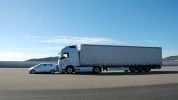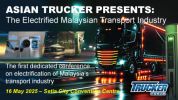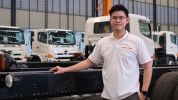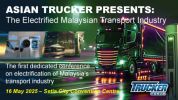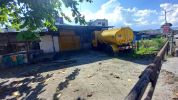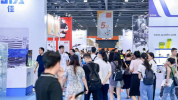Hydrogen-Powered Hyundai Trucks Soon to Roam the Swiss Alps
Powered by hydrogen, the Hyundai H2 Xcient trucks will be hitting the roads of Switzerland as a means for the Seoul-based multinational automotive manufacturer to set up a strong case for its zero-emissions technology in a low carbon world.
The Hyundai H2 Xcient, with a loading capacity of 18 tonnes, has a 190-killowatt fuel cell and seven high pressure tanks that are capable of holding up to 35kg of hydrogen. This powerful combination of technology gives the truck a range of more than 400km.
Most of hydrogen is extracted from natural gas in a process that produces carbon emissions. Despite having first developed nearly two centuries ago, hydrogen fuel cells have over the years trailed behind as the push for green transport gave rise to combustion engines. On top of that, because hydrogen is expensive and hard to store, hydrogen fuel cells have also started falling behind with the introduction of electric batteries.
There is, however, good news for hydrogen fuel cells in the trucking industry. Despite the ability and higher costs of hydrogen-based energy, Hyundai, along with its partners, has argued that electric batteries are severely lacking in mountainous areas as bigger payloads would ultimately necessitate a bigger and heavier battery, and this would prove as a problem for crawling up the rocky mountains. But in Switzerland, with more than half of the country’s energy derived from hydropower, the Hyundai team responsible for green energy technology says that there exists the potential to extract “green” hydrogen from water with electrolysis–an energy-intensive, albeit carbon-free, process–if powered by renewable electricity.
“It is not enough to produce a truck. You have to take care of the entire ecosystem, find like-minded partners, and show this all makes sense for the customer,” said Mark Freymueller, Chief Executive of Hyundai Hydrogen Mobility (HMM). While Switzerland’s green hydrogen will be far more expensive to generate than it will be for diesel, the South Korean motor company is confident that it will be a potentially big player in the market as soon as government bodies clamp down on carbon emissions which would consequently bring down the cost of clean fuel production. “It is possible to do this with a holistic approach and the right mindset.”
HYVA Offers Scissor Lifts
While the brand is famous for their front end telescopic cylinders, Hyva has reacted to market demands and added underbody scissor lifts to their portfolio. Already put to action in Indonesia is their own 32 tons underbody scissor system for dump trucks . "We are world market leader in front end telescopic cylinders, but this part of the market is used to underbody scissors. We as Hyva has this in our range as well, together with our reliable hydraulics from the telescopic cylinder this is a perfect solution for Japanese as well European trucks," said Jeffrey Zuidgeest, Managing Director of PT. Hyva Indonesia.
According to him, more variants of the scissor lift are being introduced now to accommodate various uses. The in-house development was spurred by the demand from the market and introduced to the Indonesian market in recent exhibitions. Hyva observed that there is a preference for underbody scissor lifts in Southeast Asia, whereas the system is not the favoured option in Europe. "One advantage of the scissor lift is the slightly faster tipping cycle, which seems to be the determining factor here, where mining operations are making up a big part of our market," Zuidgeest added.
Improved Service Locator Live
Asian Trucker announces the re-launch of the Service Locator Map. It now comes with additional functionality and improved user interface. The comprehensive locator shows listed businesses and allows for users to find the nearest workshop.
In tandem with a revised website, the Service Locator Network was given an update too. Based on the original tool, there have been several improvements. For example, users of mobile devices can now search for the nearest workshop and immediately call or have the route to the location shown.
Visually more attractive, the locator will initially show several hundred locations with new ones added as and when businesses decide to use this tool to advertise their location to the market. Asian Trucker noted that many workshops do not have an online presence or Google location listing. Using the Locator as their advertising avenue, workshops can quickly and efficiently put their name on a map.
In addition, service networks can be compared between brands by filtering for several makers of trucks and buses. This can be used as a tool to evaluate which brand has the best workshop coverage for specific routes.
Inceptio Technology, G7 and ENN to Build LNG Heavy-Duty Truck Routes Together
Inceptio Technology, the IoT platform G7, and the LNG giant ENN Energy Trading Co.,Ltd. ("ENN") recently signed a strategic cooperation agreement to expand their capabilities in LNG energy supply advantages, digital fuel cards, and intelligent heavy-duty truck asset management. By building LNG heavy-duty truck routes, the three parties will extend the cost advantages to logistics users.
Many factors make cost-advantageous LNG heavy-duty trucks inaccessible to logistics users
Being more economical and generating cleaner, more environmental-friendly emissions, liquid natural gas (LNG) heavy-duty trucks have a clear advantage over their diesel counterparts. In reality, however, many factors prevent logistics users from enjoying the LNG cost advantages.
Here are the major challenges faced in the application of LNG heavy-duty trucks: First, with LNG stations few and far between, especially along highways, truckers often have to drive at least 50 kilometres to the next refuelling station. Next, natural gas is susceptible to price fluctuations in foreign and domestic futures markets. The volatile nature prevents logistics companies from estimating fuel costs. In addition, LNG vehicle and refuellingtechnologies have yet to be improved. The poor gas mileage out of LNG cylinders and time-consuming fuelling process fail to meet the needs of logistics users for a timely and efficient transportation.
An industry-first "intelligent heavy-duty trucks + energy services" mode offers a major cost advantage to logistics users
An "intelligent heavy-duty trucks + energy services" mode is a feature of this cooperation. Simply by leasing Inceptio Technology's LNG heavy-duty trucks and obtaining the G7 Fuel Card, logistics customers can enjoy exclusive stable and low prices all year round at gas stations along the planned routes. This translates to significant Total Cost of Ownership (TCO) savings of RMB 100000 or more for each truck. Inceptio Technology offers logistics customers with LNG heavy-duty trucks compliant with National Standard VI that have addressed the issues of limited mileage and slow refuelling.
Refuelling stations have now been positioned at the Changan, Changshan and Hengshishui Service Areas along the Shanghai–Guangzhou route, the first outcome of the cooperation. With major cities in Eastern and Southern China covered, Inceptio Technology, G7 and ENN will replicate the innovative "intelligent heavy-duty trucks + energy services" mode for trunk roads across the country to build a nationwide service network and extend major cost advantages to logistics users.
Inceptio Technology and G7 have also launched an intelligent asset management platform providing assets as a service throughout the vehicle lifecycle, including the flexible leasing of LNG heavy-duty trucks, vehicle customization, digital LNG post-payment, and aftermarket services.
Combining innovative advantages to lower costs and increase efficiency for customers
This cooperation combines the core technologies and innovative advantages of Inceptio Technology, G7 and ENN, and is a major milestone in their continuing efforts to lower costs and increase efficiency for customers.
Supply chain innovations by ENN to address the shortage of LNG stations and LNG price fluctuations.
With its robust LNG supply chain advantages, ENN locks in LNG prices,so thatInceptio Technology's customers can enjoy exclusive stable and low rental prices all year round for LNG heavy-duty trucks. ENN also positions LNG stations for line-haul logistics to ensure that refueling facilities are available along highways.
Inceptio Technology's intelligent heavy-duty trucks and financial innovations provide full vehicle lifecycle services.
Inceptio Technology offers intelligent heavy-duty trucks and financial innovation. By building asizeable pool for leasing LNG heavy-duty trucks, it creates a stable customer base for the sustainable operations of LNG stations and energy suppliers. It also provides assets as a service throughout the vehicle lifecycle, ranging from the flexible leasing of trucks to aftermarket services.
G7's upgraded IoT technologies enable the digital management of vehicles and energy.
With its IoT platform advantage, G7 has built a digital fuel card network covering the logistics trunk lines across the country. Vehicle operational information and the digital fuel cards are linked to the LNG energy station network, allowing logistics customers and energy suppliers to implement digital management.
This three-pronged approach with intelligent heavy-duty trucks, IoT technologies, and energy supply chains marks the beginning of a new era of intelligent asset services. The logistics industry will take a step further toward lower costs and higher efficiency.
*Pictured are representatives of ENN, Inceptio Technology and G7 who attended the signing ceremony namely Zheng Hongtao, President of ENN (fifth from left), ZhaiXuehun, Founder & CEO of G7 (fourth from right), and Ma Zheren, President of G7 and Founder & CEO of Inceptio Technology (fourth from left).*
Invitation to Superpowers of Steel
If you are a cost-sensitive and performance oriented steel user, this is good news! Dates for the event will be released shortly.
Is Blue.care⁺ an effective aid in reducing the risk of corona infection?
It should also be noted that the fan used in the Blue.care⁺ operates at only about 2/3 of its air
exchange capacity in nominal operation. This design keeps the noise level low in nominal operation
(1,150 m³ at about 80m²). Otherwise, there might be a tendency among users to turn down the
volume flow rate too far in classrooms or meeting rooms.Executive Summary
In addition to hygiene rules, keeping a distance and wearing community masks, measures for stopping the rapid increase in corona infections include airing out rooms and the use of portable air purifiers. Portable air purifiers can be very effective in minimizing the risk of indirect infection.
But there are several things to consider that are important for the effectiveness of an air purifier in the context of a pandemic. The Blue.care⁺ has therefore undergone close examination. Including practical tests at the Münster university clinic, which were carried out by Hybeta GmbH, an accredited independent test lab. Conclusion: Blue.care⁺ passes the test.
Introduction
During the past weeks, new analyses and recommendations for controlling corona infections have appeared almost daily. Extensive studies are published, sometimes leading to controversial discussions. Various experts publish reports to analyze what is happening around us and to derive remedial measures. Portable air purifiers play a central part in the measures under discussion.
The flood of information on this subject is not easy to digest, and it is even more difficult to draw correct and appropriate conclusions. But many decision-makers are wondering what they can or must do to reduce the risk of infection within their area of responsibility.
The goal of this white paper is to summarize the most important aspects concerning portable air purifiers.
Background – Why do we Need a Portable Air Purifier?
The transmission of SARS-CoV-2 viruses is attributed primarily to droplets exhaled by infected people. The smallest of these droplets, which contain infectious viruses, form so-called aerosols, which can remain in suspension for a very long time. It is astounding how many viruses there can be in the air exhaled by a “spreader”. If there is a spreader in the room, the infectious aerosols accumulate in the indoor air.
Inhaling such infectious aerosols is currently considered the most important cause of indirect infection with the corona virus and its rapid spreading. The decisive factors for such a possible infection are the viral load – the concentration of viruses in indoor air – and the duration of one’s stay in that atmosphere.
If the viral load cannot be reduced sufficiently by frequent airing out or a central ventilation system, the use of portable air purifiers is recommended. The goal of an air purifier in this case must be to effectively reduce the concentration of aerosol droplets in the air. If that is successful, then one can also minimize the risk of indirect infection with the corona virus.
What is Important here, and what can Blue.care⁺ do?
A portable air purifier draws in the air in a room, filters out any contaminations as thoroughly as possible, and then distributes clean air back into the room. But the machine can fulfill its purpose only if the result can be proven in practice. For this purpose, Blue.care+ was tested in practical operation at the Münster university clinic (UKM) by Hybeta GmbH, an accredited independent test lab. Hybeta based its test on the DIN EN ISO 14664-1 standard for the design of cleanrooms.
a) Filtration
For especially effective filtration, most experts recommend HEPA filters with a filtration efficiency class of H14. What does that mean? HEPA filters belong to the class of highest-quality air filters and are used for example in hospitals and cleanrooms. Such filters are tested in accordance with the EN 1822-1 standard. H14 stands for a minimum filtration efficiency of 99.995 % for all relevant particle sizes, and therefore also in the especially important range of less than 1 µm. This is the order of
magnitude that is relevant for infectious aerosols. And: droplets of this size additionally have the capability of penetrating very deeply into the lungs when inhaled.
How can Blue.care⁺ help here?
The filter system used in the Blue.care+ passed the test as a HEPA filter with filtration efficiency class H14 according to EN 1822-1. But that is not all: the use of a HEPA filter only makes sense if it seals properly and is installed without being damaged – this is essential for the user, because otherwise the filter capacity of the machine would not be achieved despite the use of a high-quality filter.
b) Air Exchange Capacity and Effectiveness in Indoor Air
In general, it holds that the more clean air the air purifier can supply, the lower are the particle concentrations. In practice, however, this is limited by various factors. For use in classrooms, meeting rooms, etc. it is recommended to optimally have a volume flow rate that corresponds to 6 times the room volume (the so-called “air exchange rate”). Other experts claim that an air exchange capacity of 1 000 m³/h is necessary to achieve sufficient reduction of virus-carrying aerosols from a spreader in the room.
In addition to the calculated reduction effect, air exchange is also necessary, since turbulent air flow ventilation can also be achieved by using a portable air purifier. This means that the clean air is distributed quickly and evenly, so that the concentration of droplets is reduced to the same level everywhere in the room.
How can Blue.care⁺ help here?
The machine has a nominal volume flow rate of 1,150 m³/h. According to the above relationship, it is therefore possible to achieve an air exchange rate of 6 times per hour in rooms with a size of up to about 200 m³. In combination with the aforementioned filter class, it is obvious why the Blue.care+ achieved such impressive air purification results in the practical test at the UKM.
The basic load in the meeting room used for the test, which had a size of 141 m³, was reduced by between 94 and 95 % in 60 minutes of operation. That corresponds to a reduction of the basic load from class 8 to class 7 according to DIN EN ISO 14644-1. It is important not to confuse the purification effect achieved in the room with the filter efficiency (H14 or ≥ 99.995 %, see above). Because what the filter achieves on its own is more of a theoretical variable for the user. The decisive factor is the effect in the indoor air, which was the focus of the practical test at the UKM.
It is noteworthy that this was achieved in the case of particles with a size of 0.5 µm, which is relevant for the transmission of viruses. In addition, this reduction was confirmed at all 10 measurement points, which proves the consistent efficiency of the Blue.care+ throughout the entire room.
Summary
The Blue.care⁺ features HEPA filter class H14 and a nominal volume flow rate of 1,150 m³/h. In practical tests by an accredited independent test lab, this achieves particle reduction between 94 and 95 % in reproducible conditions. These tests are based on a relevant particle size of 0.5 µm.
The Blue.care⁺ is therefore indeed a proven aid in reducing the risk of corona infection.
Issue 2020
COVERSTORY:
Asian Trucker Malaysia Issue
Feature Story:
Big Data from Head to Trailer
Issue 2020
COVERSTORY:
Asian Trucker Malaysia Issue
Feature Story:
Big Data from Head to Trailer
Issue 2020
COVERSTORY:
Asian Trucker Malaysia Issue
Feature Story:
Big Data from Head to Trailer
Issue 2020
COVERSTORY:
Asian Trucker Malaysia Issue
Feature Story:
Big Data from Head to Trailer
Issue 21
- Magazine Poster Image: images/all_magazines/issue21_copy_1.jpg
- Upload a PDF or Audio wait until uploaded, then save the article.: images/all_magazines/issue21.pdf
Petron Pumps its Business from the Philippines into Malaysia
SAFE ROADS:
Volvo Supports Drivers with Safety Features
COMPANY PROFILE
WY Supreme Auto Parts Sdn Bhd
Issue 22
- Magazine Poster Image: images/all_magazines/issue22_copy_1.jpg
- Upload a PDF or Audio wait until uploaded, then save the article.: images/all_magazines/issue22.pdf
The Truth About Retreads
EVENTS:
MCVE 2021 - Regional Launchpad
HISTORY
MAN - Always Driven by Alternatives
Issue 23
- Magazine Poster Image: images/all_magazines/issue23_copy_1_copy_1.jpg
- Upload a PDF or Audio wait until uploaded, then save the article.: images/all_magazines/issue23_copy_1_copy_1.pdf
The Longest Bus Journey in the World!
ON THE GROUND:
A Vital Industry at the Brink of Another Crisis?
ENVIRONMENT:
Better Together: Supernice and Scania Ecolution
Issue 24
- Magazine Poster Image: /images/magazines_buses_2010-today/q4_copy_1_copy_1.png
- Upload a PDF or Audio wait until uploaded, then save the article.: /images/magazines_buses_2010-today/Q4-2022_copy_1.pdf
Issue 24
- Magazine Poster Image: images/all_magazines/Issue24.jpg
- Upload a PDF or Audio wait until uploaded, then save the article.: images/all_magazines/issue24.pdf
Tech in Transportation
issue 25
- Magazine Poster Image: /images/magazines_buses_2010-today/q3_copy_1_copy_1.png
- Upload a PDF or Audio wait until uploaded, then save the article.: /images/magazines_buses_2010-today/q3-2020.pdf
Issue 26
- Magazine Poster Image: /images/magazines_buses_2010-today/issue26_copy_1.jpg
- Upload a PDF or Audio wait until uploaded, then save the article.: /images/magazines_buses_2010-today/issue26_copy_1.pdf
Issue 27
- Magazine Poster Image: /images/magazines_buses_2010-today/issue27_copy_1.jpg
- Upload a PDF or Audio wait until uploaded, then save the article.: /images/magazines_buses_2010-today/issue27.pdf
Issue 33
- Magazine Poster Image: images/all_magazines/issue33_copy_1.jpg
- Upload a PDF or Audio wait until uploaded, then save the article.: images/all_magazines/issue33_copy_2.pdf
- JPG/PNG/GIF Poster Image Magazines Singapore: /images/magazines_singapore_2010-today/issue33.jpg
- Upload a PDF or Audio wait until uploaded, then save the article.: /images/magazines_singapore_2010-today/issue33.pdf
